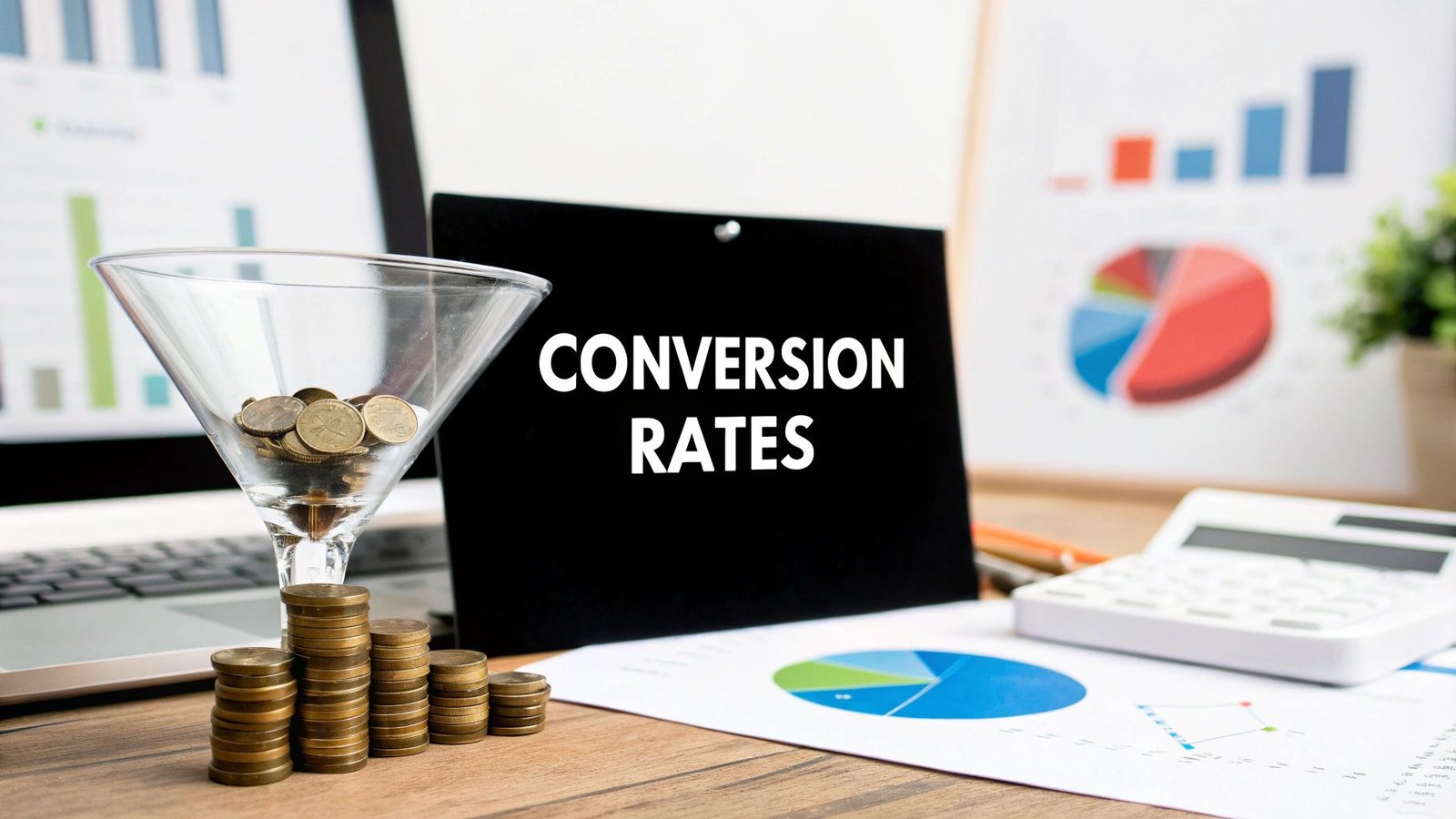Think of your sales funnel conversion rates as the vital signs for your business. They tell you the percentage of people who successfully move from one stage of your sales process to the next. In simple terms, these numbers reveal how good you are at turning curious onlookers into actual customers.
Understanding Your Customer Journey
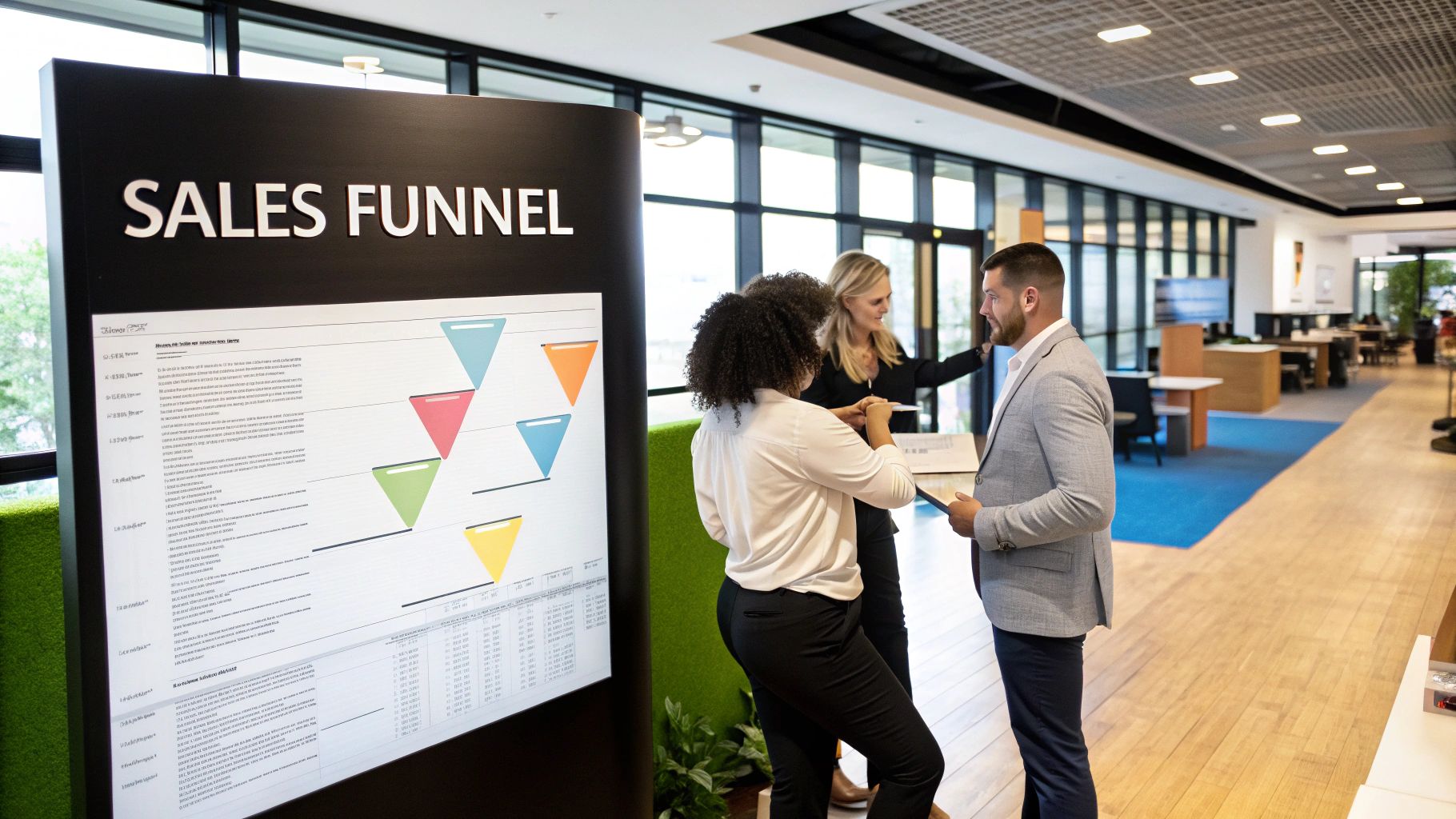
Imagine your sales funnel is the path a customer takes with your brand. It's wide at the top, capturing anyone who shows even a flicker of interest, and gradually narrows as only the most serious prospects move toward buying. The conversion rate is what tells you precisely how many people are making it through each gate along that path.
Let's use a real-world example. Say 1,000 people visit your website (the top of the funnel). Out of that group, 100 decide to sign up for a product demo (the middle of the funnel). Your conversion rate for that specific step is a clean 10%.
Why These Rates Matter
Keeping a close eye on these numbers is non-negotiable if you want to grow. A low conversion rate at any stage is a massive red flag—it’s a leak in your bucket. Is your landing page copy falling flat? Is your call-to-action buried? You can't fix a problem you can't see, and that's where the data comes in.
By analyzing your sales funnel conversion rates, you can stop guessing and start making decisions backed by real numbers. It’s the only way to plug the leaks, get more from your marketing budget, and ultimately, turn more prospects into paying customers.
At the end of the day, these metrics give you a clear roadmap. They show you where you're losing people, helping you pinpoint friction in the buyer's journey and make targeted improvements that actually work.
Navigating The Four Core Funnel Stages
To really get a handle on your sales funnel conversion rates, you first have to understand the journey your customers take. It’s not a random walk; it’s a path with four distinct stops. Think of each stage as a different phase in a relationship, moving from a first impression to a firm commitment.
This journey is fundamental to sales, whether you're selling complex software or high-end consulting services.
The Four Core Sales Funnel Stages
The process kicks off at the Awareness stage. At this point, your only goal is to get noticed. A potential customer has just figured out they have a problem or a need, and your job is to pop up as a potential solution. This is the very top of your funnel, where you cast the widest net.
The image below highlights the key strategies you can use to generate that crucial initial awareness.
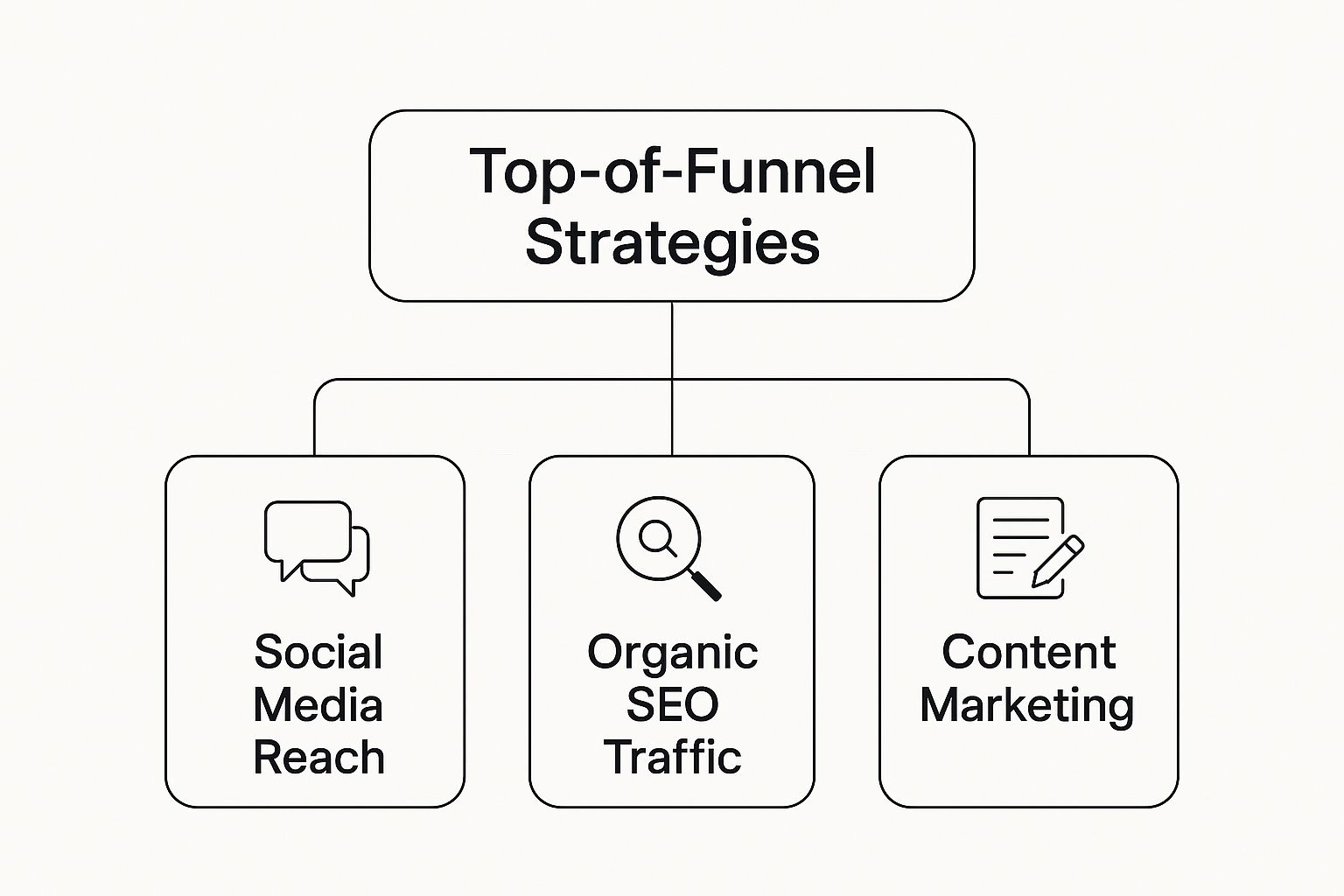
As you can see, grabbing those first eyeballs is all about a solid mix of content, SEO, and social media.
The table below breaks down these four stages, showing what you’re trying to achieve at each stop and how you might measure success along the way.
| Funnel Stage | Primary Goal | Example Activities | Example Conversion Metric |
|---|---|---|---|
| Awareness | Attract potential customers | Blog posts, SEO, social media ads, infographics | Website Visitors, Social Media Reach |
| Interest | Engage prospects and build trust | Webinars, case studies, email newsletters, e-books | E-book Downloads, Webinar Registrations |
| Consideration | Showcase your unique value | Product demos, free trials, comparison guides | Demo Requests, Trial Sign-ups |
| Action | Convert the prospect into a customer | Pricing pages, consultations, proposals, final contracts | Purchase, Contract Signed |
Each stage is a mini-conversion in itself, moving a prospect one step closer to becoming a paying customer.
From First Glance To Final Decision
Once someone knows you exist, they slide into the Interest and Consideration stages. This is where the real work begins. You're no longer just shouting into the void; you're building a relationship, proving your expertise, and demonstrating value.
A prospect might download a technical whitepaper, join a webinar to see your product in action, or scour case studies to see if you've solved similar problems for others. Your focus shifts from mass appeal to targeted, helpful education. This is where great nurturing can make or break your sales pipeline. In fact, a staggering 79% of leads never become sales simply because they weren't nurtured properly.
The goal isn't just to get their attention—it's to hold it. You need to consistently provide content that answers their questions and positions you as the expert guide they can't do without.
Finally, we arrive at the Action stage. They’ve done the research, weighed the options, and are ready to pull the trigger. Your role now is to make it dead simple for them to say "yes." This means a clear call-to-action, like a "Request a Demo" button or a "Start Your Free Trial" link. Truly understanding what B2B lead generation entails at each specific phase is the secret to a high-performing funnel.
Benchmarking Your Funnel Conversion Rates
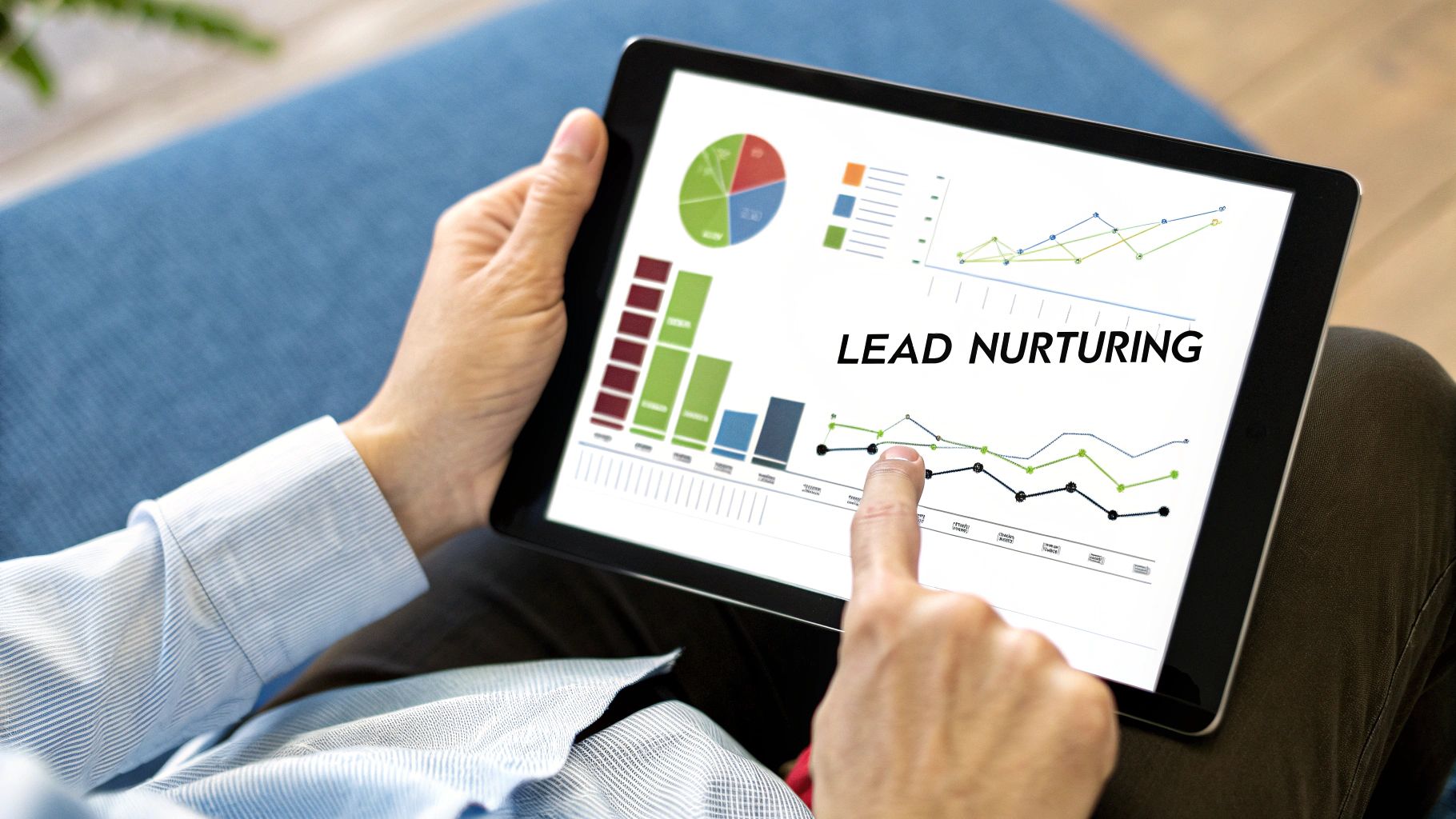
Trying to define a "good" conversion rate can feel like hitting a moving target. The truth is, there’s no single magic number. What works for a SaaS company won't be the same for an e-commerce store, because benchmarks shift dramatically based on your industry, audience, and how complex your product is.
That said, it helps to have a general ballpark figure to see where you stand. Across most industries, a typical sales funnel converts somewhere between 2% and 5% of its leads into customers. If we zoom in on landing pages, the global average is about 2.35%. But don't let that number discourage you. Top-performing companies often push past 5.3%, and the absolute best in the business can hit 11.45% or even higher. You can dig deeper into how these rates vary by industry over at Bizcognia.
Think of these numbers as a yardstick. If your rates are falling short, it's a clear signal that there's a point of friction somewhere in your funnel that needs attention.
Why Industry Averages Differ So Much
So, why the huge variation? It all comes down to context. A high-ticket B2B software sale with a six-month negotiation process is a completely different beast than an impulse buy from a social media ad.
Several key factors are always at play:
- Product Price and Complexity: The more expensive or complicated the product, the more research and consideration a buyer needs. This naturally leads to a longer sales cycle and lower initial conversion rates.
- Sales Cycle Length: A B2B deal that takes months to close will have funnel metrics that look nothing like a direct-to-consumer brand where the buying window is a matter of days.
- Traffic Source: Where your leads come from matters immensely. A warm referral from a trusted partner will almost always convert better than a cold lead from a broad advertising campaign.
The real goal isn’t to obsess over matching a global average. It's to understand your specific market and focus on making steady, incremental improvements that actually grow your revenue.
When you grasp these nuances, you can start setting realistic goals. For instance, refining your outbound lead generation can dramatically improve the quality of prospects entering your funnel, which directly boosts your chances of converting them down the line.
Decoding B2B Funnel Conversion Benchmarks
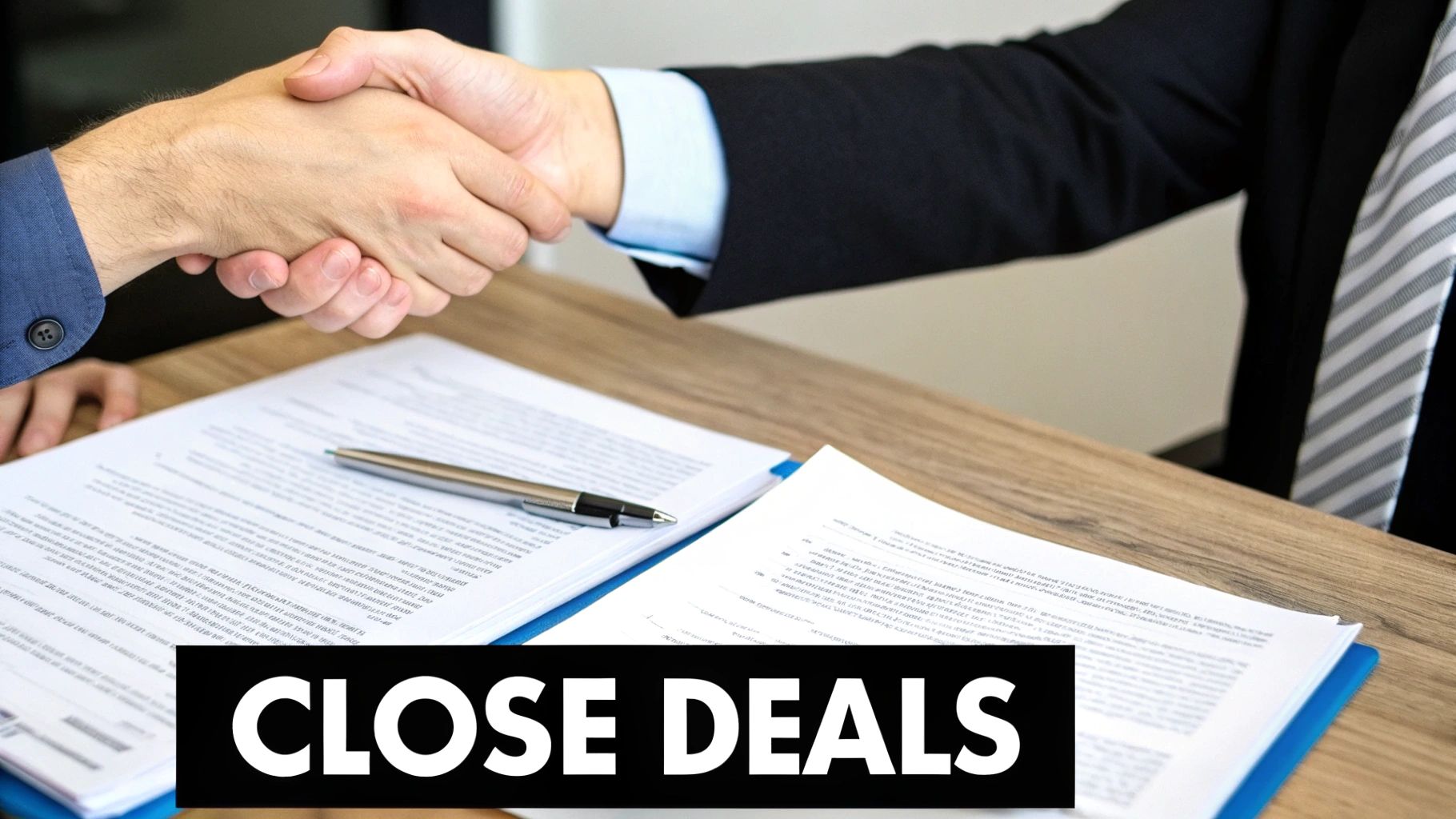
The B2B sales journey is a different beast altogether. Forget the quick, impulsive buys of the consumer world; we're dealing with longer sales cycles, multiple stakeholders, and much bigger decisions. This means generic conversion benchmarks just won't cut it.
Instead of looking at a single, overarching funnel-to-customer rate, savvy B2B teams focus on the critical handoffs between marketing and sales. This is where you get a true reading on your pipeline's health.
To do this, we need to speak the same language. A Marketing Qualified Lead (MQL) is someone who's raised their hand through marketing activities, like downloading a whitepaper or attending a webinar. From there, the sales team vets them, and if they're a good fit with real buying intent, they become a Sales Qualified Lead (SQL).
Tracking the sales funnel conversion rates between these distinct stages is how you uncover the real story of what’s working—and what isn’t.
Key Handoffs and What the Numbers Say
By zooming in on these "micro-conversions," you can stop guessing and start pinpointing exactly where your process is breaking down. Are marketers tossing unqualified leads over the fence? Is the sales team dropping the ball on follow-up? The data holds the clues.
Industry research reveals a pretty consistent pattern of filtering and drop-off. Think of it as a series of gates, each one getting a little narrower. While a good chunk of raw leads might become MQLs, the real qualification happens in the next few steps.
Here’s a look at some typical conversion ranges:
- Lead to MQL: Around 25% to 35% of marketing leads usually have what it takes to become an MQL.
- MQL to SQL: This is a big filter. The rate drops to between 13% and 26% as the sales team confirms genuine purchase intent.
- SQL to Opportunity: Once a lead is truly qualified, the odds get much better. The conversion rate here jumps to 50% to 62%, as these are now serious sales conversations.
- Opportunity to Closed Deal: The final hurdle sees a 15% to 30% conversion rate, turning a promising opportunity into a new customer.
By looking at the funnel this way, you can shift from asking a vague question like, "Why aren't we closing more deals?" to a specific one: "Why are we losing 75% of our MQLs before they even become SQLs?" That level of detail is the key to making changes that actually work.
These numbers make it clear: the B2B funnel is a tough filtration system by design. You can learn more about these sales funnel conversion benchmarks and their impact to get a better handle on diagnosing your own pipeline's performance.
What Really Moves the Needle on Conversion Rates?
Knowing your funnel benchmarks is a great start, but the real magic happens when you figure out why leads are dropping off. Several key factors can turn your sales funnel from a leaky bucket into a well-oiled machine. These aren’t just theories—they're specific parts of your process you can look at and fix right now.
One of the most common culprits is something surprisingly simple: website performance. We all live in an "I want it now" world, and even a one-second delay can kill a conversion. A slow landing page tells a potential customer you don't value their time before they've even read a single word.
The numbers don't lie. Online stores that load in about one second see conversion rates 2.5 times higher than sites that take five seconds to load. You can see for yourself how loading speed affects sales funnels and why every millisecond truly matters.
Your Mobile Experience Can Make or Break You
Beyond sheer speed, how your site performs on a phone is just as critical. A huge chunk of B2B research now happens on mobile devices, so a clunky, hard-to-use mobile site is an absolute deal-breaker. If someone has to pinch and zoom just to figure out what you do, they’re gone.
A responsive design that looks and works great on any screen isn't just a nice feature anymore; it's the price of entry. This is a foundational piece of the puzzle when you're figuring out how to generate leads today.
A slow or poorly designed mobile experience creates instant frustration. It sends a clear message that you don't prioritize a huge portion of your audience, essentially sending them straight to a competitor with a better setup.
The Role of Smart, Strategic Content
Finally, the content you create plays a massive part in guiding people through the funnel. Generic blog posts just won't cut it. You need content that speaks directly to a prospect's problems at the exact moment they're having them.
Think about using assets like these to move people forward:
- Video Testimonials: Nothing builds trust like hearing from a happy customer. These are perfect for prospects in the middle of your funnel who are weighing their options.
- Targeted Retargeting Ads: Bring back visitors who browsed but didn't take action. A specific, relevant offer can be just the nudge they need.
- In-Depth Case Studies: For prospects who are close to making a decision, a detailed case study provides the hard proof they need to feel confident in choosing you.
Alright, let's transform this section into something that sounds like it came straight from a seasoned marketing pro, not an algorithm. Here’s the rewrite.
How to Actually Measure and Improve Your Funnel
Knowing the industry benchmarks is a great starting point, but the real magic happens when you start actively improving your own sales funnel conversion rates. This is about getting your hands dirty and turning theory into a repeatable process of testing, learning, and refining.
First things first: you can't fix what you can't see. Your most important tools for this are going to be Google Analytics and your CRM. They give you the hard data you need to understand exactly how people are moving through your funnel—and, more importantly, where they’re dropping off.
Finding and Fixing the Leaks in Your Funnel
With tracking in place, the real detective work begins. Your mission is to calculate the conversion rate from one stage to the next. For example, what percentage of people who land on your blog actually sign up for the newsletter? And out of those subscribers, how many take the next step and book a demo?
Your single biggest opportunity for growth is almost always at the point of your biggest drop-off. Is it between the awareness and interest stages? Or are you losing people right before they make a purchase? Nailing down that one weak link tells you exactly where to focus your energy for the biggest return.
Once you’ve found that leak, you can start plugging the hole with targeted tactics. This is where you need to adopt a "test everything" mindset.
Here are a few proven strategies you can start with:
- A/B Test Your Messaging: Don't just guess what works. Pit different headlines, calls-to-action (CTAs), and email subject lines against each other to see what your audience actually responds to.
- Simplify, Simplify, Simplify: Is your signup form asking for too much information? Does your checkout process have too many steps? Every single field or click you can remove reduces friction and can give your conversion rate a lift.
- Refine Your Nurturing: Especially in B2B, what happens after someone signs up is critical. Improve your email sequences with relevant case studies or content that speaks directly to their problems. This keeps leads warm and guides them toward the next step.
Frequently Asked Questions
How Often Should I Check My Funnel Rates?
Think of it like checking your car's vitals. A quick, high-level glance at your overall funnel metrics should be a weekly habit. This helps you spot any sudden leaks or major problems before they get out of hand.
For a more thorough, stage-by-stage diagnosis, plan on doing a deep dive monthly or quarterly. This cadence gives your marketing and sales efforts enough time to play out, so you have meaningful data to analyze and can make adjustments that actually work.
What’s the Biggest Mistake People Make With Funnels?
Hands down, the most common mistake is treating the funnel like a one-and-done project. You can't just set it and forget it. The best funnels are living, breathing things that are constantly being tweaked, tested, and improved based on real customer behavior.
Another classic error is a jarring disconnect between the message marketing is putting out and how the sales team is actually talking to prospects. When that alignment is off, trust erodes, and your conversion rates will suffer.
Tailoring your messaging, content, and offers to specific segments will create a more relevant experience and almost always lead to better results.
Should I Have More Than One Sales Funnel?
Absolutely. Trying to force everyone through the same generic, one-size-fits-all funnel is a surefire way to get mediocre sales funnel conversion rates. Your customers are not all the same—they have different pain points, come from different industries, and are looking for different solutions.
Your funnels should reflect that diversity. Building out separate paths for different customer segments, product lines, or marketing campaigns allows you to speak directly to their specific needs, which is the key to turning interest into action.
Accelerate your B2B sales in the Nordic region. With the Nordic Lead Database, you gain direct access to decision-makers, helping you fill the top of your funnel with high-quality leads. Explore our extensive database at https://nordicleaddatabase.com and start converting more prospects today.
